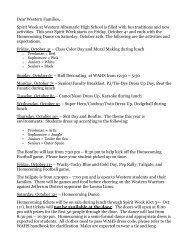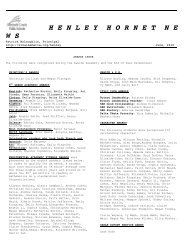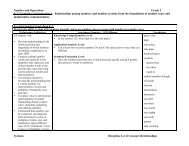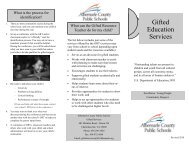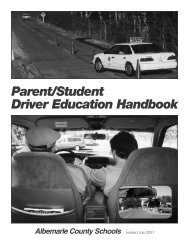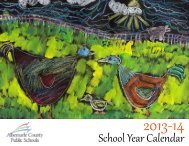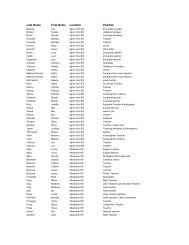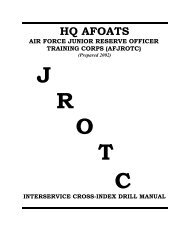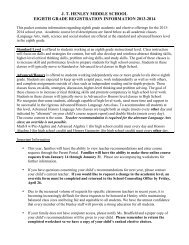Language Arts/English Curriculum Frameworks - Albemarle County ...
Language Arts/English Curriculum Frameworks - Albemarle County ...
Language Arts/English Curriculum Frameworks - Albemarle County ...
Create successful ePaper yourself
Turn your PDF publications into a flip-book with our unique Google optimized e-Paper software.
Virginia C/T SOL and Content Area SOL <strong>English</strong><br />
Technology Integration Strategies 6 th Grade<br />
In order to assist teachers who are interested in using technology for project-based learning, below is an example of a long-term project that<br />
incorporates several content and technology SOL.<br />
VA SOL Strand<br />
for Content<br />
Reading<br />
Writing<br />
VA SOL Standard for<br />
Content<br />
6.4 a, d, f and h: The<br />
student will read and<br />
demonstrate<br />
comprehension of a<br />
variety of fiction,<br />
narrative nonfiction, and<br />
poetry: identify the<br />
elements of narrative<br />
structure, including<br />
setting, character, plot,<br />
conflict, and theme;<br />
describe how word choice<br />
and imagery contribute to<br />
the meaning of a text;<br />
use information stated<br />
explicitly in the text to<br />
draw conclusions and<br />
make inferences; and,<br />
paraphrase and<br />
summarize the main<br />
points in the text.<br />
6.5 a, d, e and f: The<br />
student will read and<br />
demonstrate<br />
comprehension of a<br />
variety of informational<br />
selections: identify<br />
questions to be<br />
answered; draw<br />
conclusions and make<br />
inferences based on<br />
explicit and implied<br />
information; organize the<br />
main idea and details to<br />
form a summary;<br />
compare and contrast<br />
information about one<br />
topic contained in<br />
different selections; and,<br />
select informational<br />
sources appropriate for a<br />
given purpose.<br />
VA SOL Standard for<br />
Technology<br />
© <strong>Albemarle</strong> <strong>County</strong> Public Schools, April 2006<br />
Appendix G<br />
C/T 6-8.4: The student will<br />
practice responsible use of<br />
technology systems,<br />
information, and software.<br />
Demonstrate the correct use of<br />
fair use and copyright<br />
regulations.<br />
C/T 6-8.5: The student will<br />
demonstrate knowledge of<br />
technologies that support<br />
collaboration, personal<br />
pursuits, and productivity.<br />
Work collaboratively and/or<br />
independently when using<br />
technology. Explore the<br />
potential of the Internet as a<br />
means of personal learning<br />
and the respectful exchange of<br />
ideas and products.<br />
C/T 6-8.6: The student will<br />
use technology to locate,<br />
evaluate, and collect<br />
information from a variety of<br />
sources. Use Internet and<br />
other electronic resources to<br />
locate information in real time.<br />
C/T 6-8.7: The student will<br />
evaluate and select new<br />
information resources and<br />
technological innovations<br />
based on the appropriateness<br />
for specific tasks. Use search<br />
strategies to retrieve<br />
information. Evaluate the<br />
accuracy, relevance, and<br />
appropriateness of electronic<br />
information sources.<br />
VA SOL Essential<br />
Understanding<br />
All students should:<br />
understand that fiction<br />
includes a variety of<br />
genres, including short<br />
story, novel, folk<br />
literature, and drama;<br />
understand that<br />
narrative nonfiction<br />
includes biography,<br />
autobiography, and<br />
personal essay;<br />
understand that poetry<br />
can be rhymed,<br />
unrhymed, and/or<br />
patterned; differentiate<br />
between narrative and<br />
poetic forms;<br />
understand that imagery<br />
and figurative language<br />
enrich texts; recognize<br />
an author’s craft as the<br />
purposeful choice of<br />
vocabulary, sentence<br />
formation, voice, and<br />
tone; recognize an<br />
author’s theme(s); use<br />
graphic organizers to<br />
organize and summarize<br />
text; read beyond the<br />
printed text to<br />
understand the message<br />
stated or implied by an<br />
author; select<br />
appropriate sources of<br />
VA SOL Essential<br />
Knowledge<br />
To be successful with<br />
this standard, students<br />
are expected to:<br />
notice an author’s craft;<br />
recognize poetic<br />
elements in prose and<br />
poetry; use strategies<br />
for summarizing; use<br />
graphic organizers, such<br />
as “It says, I say” to<br />
record clues in the text<br />
and inferences or<br />
conclusions made by the<br />
reader as a result of<br />
those clues; activate<br />
prior knowledge before<br />
reading; pose questions<br />
prior to and during the<br />
reading process;<br />
comprehend, record,<br />
and remember details<br />
and/or facts in order to<br />
arrive at a conclusion or<br />
generalization; use<br />
graphic organizers to<br />
show similarities and<br />
differences in the<br />
information found in<br />
several sources about<br />
the same topic; use<br />
strategies and rules for<br />
summarizing;<br />
understand and use the<br />
references available in<br />
information based on the the classroom, school,<br />
purpose for reading; and public libraries; use<br />
use a variety of<br />
selected prewriting<br />
strategies, including techniques; elaborate to<br />
context, structural give detail, add depth<br />
analysis, and reference and continue the flow of<br />
sources, for determining an idea; understand that<br />
the meaning of<br />
revising to improve a<br />
Technology<br />
NETS-S Performance<br />
Integration Strategies Indicators<br />
Have students choose an<br />
issue (such as the<br />
balance between<br />
freedom and security,<br />
global activism, etc.) or<br />
a value (compassion,<br />
tolerance, heroism)<br />
around which they wish<br />
to build several pieces of<br />
writing for the year.<br />
Using a graphical<br />
organizer, have the<br />
students brainstorm<br />
potential sub-topics for<br />
research. Through the<br />
course of the year,<br />
weave in readings and<br />
writing assignments<br />
using the chosen topic.<br />
Have the students create<br />
a web site that collects<br />
all their information on<br />
this topic, including their<br />
own writings,<br />
recommended reading<br />
list, connections to<br />
recommended web sites,<br />
and any other pieces the<br />
students wish to include.<br />
Share the web site with<br />
the wider community by<br />
advertising it in local<br />
media outlets.<br />
Exhibit legal and ethical<br />
behaviors when using<br />
information and<br />
technology, and discuss<br />
consequences of misuse.<br />
Apply productivity/<br />
multimedia tools and<br />
peripherals to support<br />
personal productivity,<br />
group collaboration, and<br />
learning throughout the<br />
curriculum.<br />
Design, develop,<br />
publish, and present<br />
products e.g., Web<br />
pages, videotapes using<br />
technology resources<br />
that demonstrate and<br />
communicate curriculum<br />
concepts to audiences<br />
inside and outside the<br />
classroom.<br />
Collaborate with peers,<br />
experts, and others<br />
using<br />
telecommunications and<br />
collaborative tools to<br />
investigate curriculumrelated<br />
problems, issues,<br />
and information, and to<br />
develop solutions or<br />
products for audiences<br />
inside and outside the<br />
classroom.<br />
Research and evaluate<br />
the accuracy, relevance,<br />
appropriateness,<br />
comprehensiveness, and<br />
bias of electronic<br />
6



